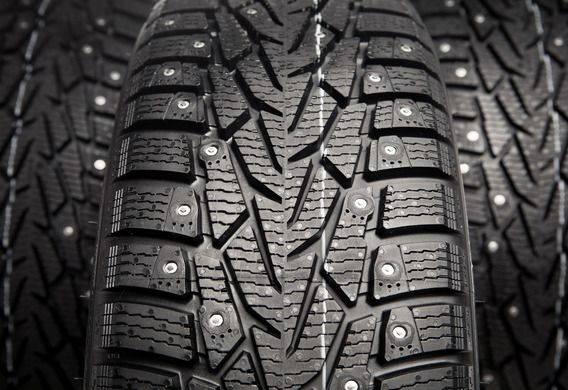
"The spitless or the unbearded winter rubber?"-the dispute has been among the motorists for more than half a century, and by degree of relevance, it is not inferior to the gleam "To be or not to be?". So, what is a security guarantor or a problem?
By the way, the motorists of the middle of the 20th century did not have such questions, because the first winter tires were exactly the same. Moreover, they differed only from the presence of special protruding elements on the surface of the summer tyres, affording better adhesion on the ice or tightly packed snow. The worthy analogue of the studly tyres-"sticky rubber"-"Velcro"-appeared only after a few decades, in the 1990s.
Evolution of tyre tyres
In the 19th century, the blacksmiths came up with the idea of putting nails in leather ones on the wheels of the carriage and the carts. The improvement of driveability in winter was first thought in Scandinavia in the 1930s. At the same time, in the northern European countries, modern studding tyres appeared in the usual rubber tyres, with small bolts swinging and swelling with the help of the ghak. The main advantage is the increase of stability and controllability of the car on the winter road. The main drawbacks are the increase in the mass of the wheel and not a very large resource.
Gradually, it became clear that the metal spike was a good help on a solid slippery hanging, and in the loose snow they were useless. In addition, the road surface was spoiled by thoracic asphalt in contact with the asphalt. As a result, in Japan and some European countries with mild climate, the use of studyrubber was prohibited.
Major bus companies offered different alternatives to drivers. Dunlop, for example, decided to use the "brush effect" and released tyres with pieces of steel wire in the tread. Another original idea was a tyre with "suction"-holes in the contact spot, which created vacuum vacuum and improved the clutch.
Also as an alternative to the thoracic tyres were offered principally new friction tyres (the people were nicknamed "Velcro") made of rubber of the new composition and literally "sticky" to the pavement.
In parallel, the idea was to replace metal spies with plastic. The main drawback of this material was its lack of strength: the plastic was rapidly worn under load and it was destroyed by the temperature difference. Later, it was decided to use for the manufacture of aluminum, which is comparable in mass with plastics, and by strength with steel. In order to extend the period of service of aluminium chippers, they were covered by teflon.
In order to reduce the devastating impact of tyre rubber on the road surface, some of the tyre models have been fitted with "pads" installed under each spike. When the spike reaches a solid surface, it is cleaned inside the tyres and is not worn due to the contact with the asphalt.
Modern studish tyres
The spires on modern snow tyres consist of two parts: a hull from soft steel or aluminium alloy and a hard-smooth working pasting.
All the spike can be divided into single-flanged and multi-flange. Single-flange spike-the simplest and cheapest, in shape like a carnation or a stickup with a straight "leg". Two-flanges or triflanges are worth more, but it is more reliable "sitting" in the cap by the relief of the leader pin. Single-flanged and double-flanged thoracic spike are used mainly in passenger cars, while the triflange is used on trucks and special equipment.
The shape of the spines varies from one firm to the other. The most commonly used round spiplings are oval or square. And Nokian, for example, offers its purchasers with diamond-shaped tyres.
The number and location of the thorines is carefully calculated to achieve optimal chaining. Most of the time, the tyre has 90 to 120 thorines. Ideally, there should be between 8 and 12 thoracic spots in the contact spot at the same time.
Sheet rubber: behind and against
The dispute over the thorn rubber is one of the most acute among motorists. The "for" arguments are the reduction of the stopping distance, the improvement of driveability, the elimination of wheel inching, the increase of the stability of the car on ice or the dense snow. However, it is not worth forgetting that thorn rubber is not a panacea for all the trouble of winter driving. For example, on cleared of snow and ice, the width of the rubber rubber is worse than the unbearings, and in the snow-neck, the presence of spips does not affect the quality of the clutch.
In contact with asphalt, the thorn not only props the deep tracks, but also leads to the formation of harmful dust, which, according to the doctors, can cause respiratory diseases. The deficiencies may also include increased noise levels and higher vehicle fuel consumption.
As soon as the spigot starts to be unseaworthiness or to fly out of seats, the wheel has to be replaced. Sheep rubber, which has been stripped of the thorn, will not become "Velcro" and will not be able to provide the proper level of safety, so its further exploitation can lead to an accident.
Undoubtedly, the spike in the winter rubber has a number of advantages, but it can only be fully evaluated under certain operating conditions. In the conditions of a snowy winter, or in the case of wet snow, even the most modern and expensive tyres will not have advantages over the unshied analogues.







